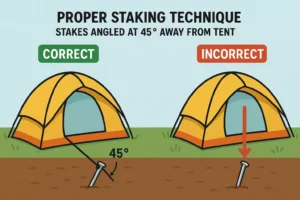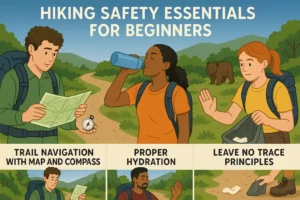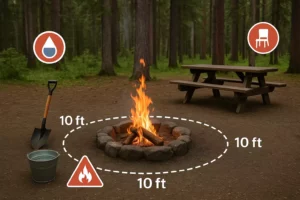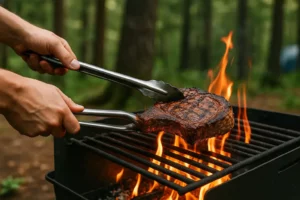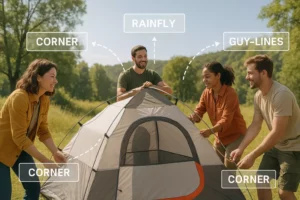The Easiest Way to Fold a 4-Person Tent (It Fits in the Bag!)
Picture this: You’ve just finished an amazing camping trip with friends, the memories are fresh, and everyone’s ready to head home. But then comes the dreaded moment – packing up the tent. What started as a neatly folded package now resembles a wrestling match with fabric and poles that seems impossible to win. Sound familiar? You’re not alone in this struggle, and the good news is that folding a 4-person tent doesn’t have to be a frustrating ordeal that leaves you sweating and questioning your outdoor skills.
Key Takeaways
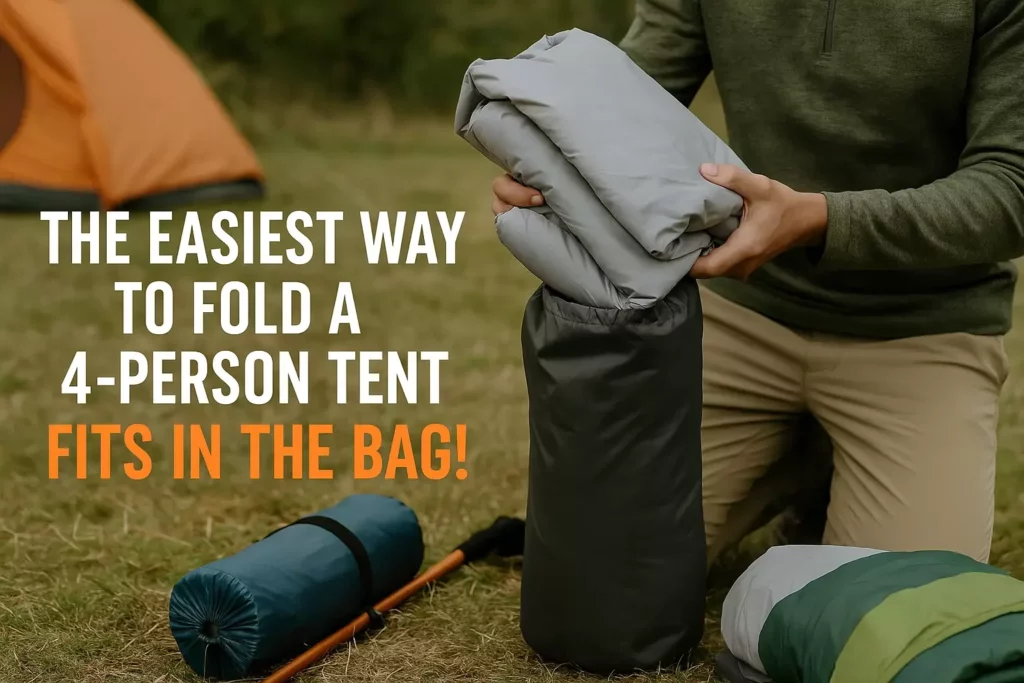
- Preparation is crucial – Clean and dry your tent completely before attempting to fold it to prevent mold and extend its lifespan
- Follow the reverse setup order – Remove stakes and guy lines first, then collapse poles systematically for easiest folding
- Use the “burrito roll” technique – Lay the tent flat, fold in thirds, then roll tightly from one end to compress it efficiently
- Practice at home – Familiarize yourself with the folding process in your backyard before heading out on camping trips
- Proper storage matters – Store your tent loosely at home and only compress it tightly when traveling to maintain fabric integrity
Why Proper Tent Folding Matters More Than You Think
Before diving into the step-by-step process, it’s essential to understand why learning the correct folding technique is worth your time and effort. Proper tent folding isn’t just about convenience – it directly impacts your tent’s longevity, your camping experience, and even your safety on future trips.
When you fold your tent correctly, you’re protecting a significant investment. A quality 4-person tent can cost anywhere from $100 to $500 or more, and improper folding can lead to premature wear, damaged zippers, bent poles, and fabric stress points that eventually become tears.
The Hidden Costs of Poor Folding Technique
Many campers don’t realize that forcing a tent into its stuff sack can cause microscopic damage that accumulates over time. This includes:
- Zipper misalignment that leads to stuck or broken zippers
- Pole stress fractures from being bent at unnatural angles
- Fabric stretching that reduces waterproofing effectiveness
- Seam separation from excessive pressure and cramming
Additionally, a properly folded tent makes your camping experience more enjoyable by ensuring quick and easy setup on your next adventure.
Essential Preparation Steps Before Folding
Step 1: Complete Tent Inspection and Cleaning
Start by conducting a thorough inspection of your tent while it’s still set up. Look for any damage, debris, or moisture that needs attention. This is your opportunity to address issues before they become bigger problems during storage.
What to check for:
- 🔍 Tears or holes in the fabric
- 🔍 Bent or damaged poles
- 🔍 Stuck or damaged zippers
- 🔍 Missing or damaged stakes
- 🔍 Dirt, pine needles, or other debris
Step 2: Ensure Complete Dryness
Moisture is your tent’s biggest enemy during storage. Even small amounts of dampness can lead to mold, mildew, and fabric degradation. If your tent is wet from rain or morning dew, take the time to dry it completely.
Drying strategies:
- Set up the tent in direct sunlight for 30-60 minutes
- Use a clean towel to wipe down wet surfaces
- Shake out the tent to remove excess moisture
- Allow air circulation by opening all vents and doors
Pro Tip: If you must pack a damp tent due to weather conditions, unpack and dry it within 24 hours to prevent permanent damage.
Step 3: Remove All Accessories and Hardware
Before beginning the folding process, remove all external components:
- Stakes and guy lines – Clean and organize these separately
- Rainfly – This should be folded separately from the main tent body
- Footprint or tarp – Clean and fold according to its specific requirements
- Loose items – Check pockets and storage areas for forgotten gear
The Complete Step-by-Step Folding Process
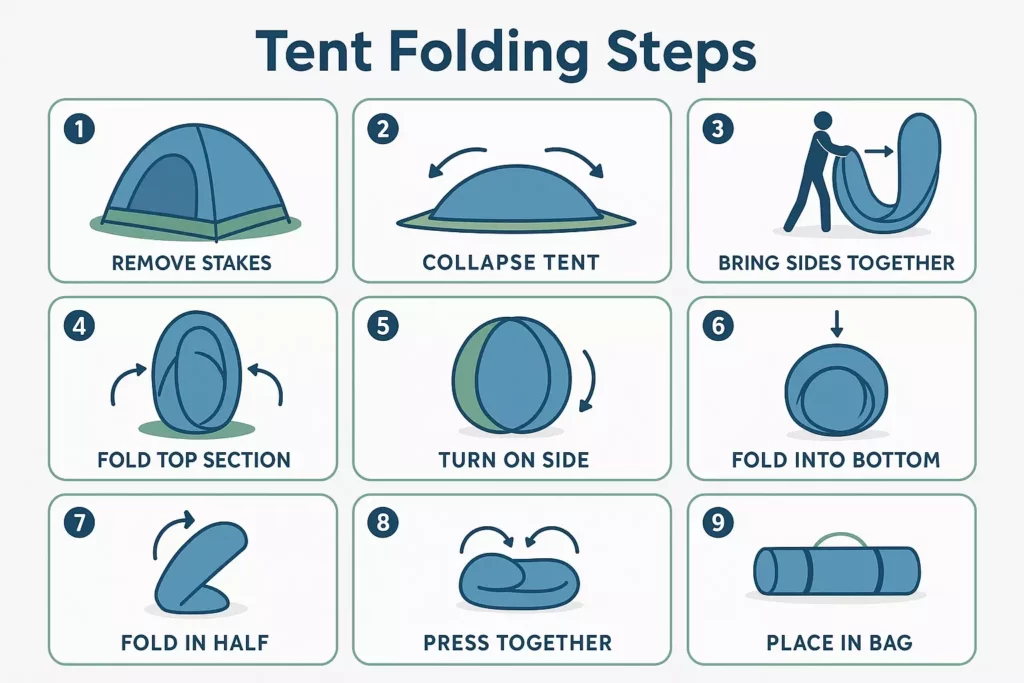
Phase 1: Disassembly and Initial Breakdown
Step 1: Remove Stakes and Guy Lines
Start from the outside and work your way in. Remove all stakes by pulling them straight up to avoid bending. Coil guy lines neatly to prevent tangling – this simple step will save you significant time during your next setup.
Step 2: Detach the Rainfly
Most 4-person tents have a separate rainfly that should be removed first. Unclip or untie all attachment points, starting from the corners and working toward the center. Fold the rainfly separately using the same technique you’ll use for the main tent body.
Step 3: Collapse the Tent Structure
Begin collapsing the tent by pushing the poles inward from the corners. Work systematically – don’t try to collapse everything at once. Most 4-person tents use a hub system or color-coded poles that make this process more intuitive.
Phase 2: Pole Removal and Management
Step 4: Remove Poles Carefully
This is where many campers make critical mistakes. Never pull poles out forcefully or allow them to snap together uncontrolled. Instead:
- Disconnect poles from tent clips or sleeves
- Carefully push pole sections together rather than pulling them apart
- Allow the shock cord to guide the collapse naturally
- Keep pole sections organized and aligned
Step 5: Organize Hardware
Place all poles, stakes, and small hardware in designated pockets or bags. Many tents come with specific storage solutions for these components. Keeping hardware organized prevents loss and makes setup much faster.
Phase 3: The “Burrito Roll” Folding Technique
This proven method works for virtually all 4-person tent designs and ensures a compact, manageable package.
Step 6: Create Your Base Layer
Lay the tent body flat on a clean surface with the door zippers closed. Smooth out all air pockets and wrinkles – these create bulk that prevents proper folding. Orient the tent so the longest dimension runs left to right in front of you.
Step 7: Execute the Initial Fold
Fold the tent in half lengthwise, bringing one long edge to meet the other. Press out air as you fold to minimize bulk. The tent should now be roughly half its original width.
Step 8: Create the Final Fold
Depending on your tent’s size and stuff sack dimensions, you may need to fold in half again or fold in thirds. Check your stuff sack dimensions before making this decision – it’s better to fold once more than to struggle with cramming.
Step 9: The Rolling Process
Starting from the end opposite the doors (to push air out through openings), begin rolling the tent tightly. Apply consistent pressure as you roll, and stop periodically to press out air pockets.
Important: Roll slowly and deliberately. Rushing this step often results in an uneven roll that won’t fit in the stuff sack.
Advanced Techniques for Stubborn Tents
The Compression Method
Some 4-person tents are simply too bulky for traditional folding methods. In these cases, compression techniques can be lifesavers:
Technique 1: Graduated Compression
- Fold the tent as described above
- Place it in the stuff sack
- Compress gradually, working air out in stages
- Use body weight to assist compression, but avoid excessive force
Technique 2: The Vacuum Method
- Fold the tent normally
- Open one small section of the stuff sack
- Press out air while simultaneously closing the opening
- Repeat until the tent reaches desired compression
Dealing with Specific Tent Designs
Hub-Style Tents:
These tents have a central hub where all poles connect. Collapse the hub first, then work outward to prevent pole binding.
Tunnel Tents:
Start collapsing from one end and work systematically toward the other. Maintain the tunnel shape during initial collapse to prevent fabric bunching.
Dome Tents:
These are typically the easiest to fold. Collapse opposite corners simultaneously to maintain structural integrity during breakdown.
Troubleshooting Common Folding Problems
Problem 1: Tent Won’t Fit in Stuff Sack
This is the most common complaint among campers. Don’t panic – there are several solutions:
Solutions:
- Ensure the tent is completely dry (wet fabric takes up more space)
- Re-fold more tightly, pressing out all air
- Check that you haven’t included items that should be stored separately
- Consider that some tents are designed to fit snugly and require patience
Problem 2: Poles Keep Springing Apart
Shock cord tension can make pole management challenging:
Solutions:
- Hold pole sections firmly while disconnecting
- Work in a windless environment when possible
- Consider replacing shock cord if it’s overly tight or loose
- Practice pole management at home to build muscle memory
Problem 3: Fabric Bunching and Wrinkles
Bunched fabric prevents proper compression and can damage your tent:
Solutions:
- Take extra time to smooth fabric during each fold
- Work on a clean, flat surface
- Ensure all zippers are closed to maintain fabric tension
- Consider the tent’s fabric type – some materials are more prone to bunching
Maintenance Tips for Long-Term Tent Care
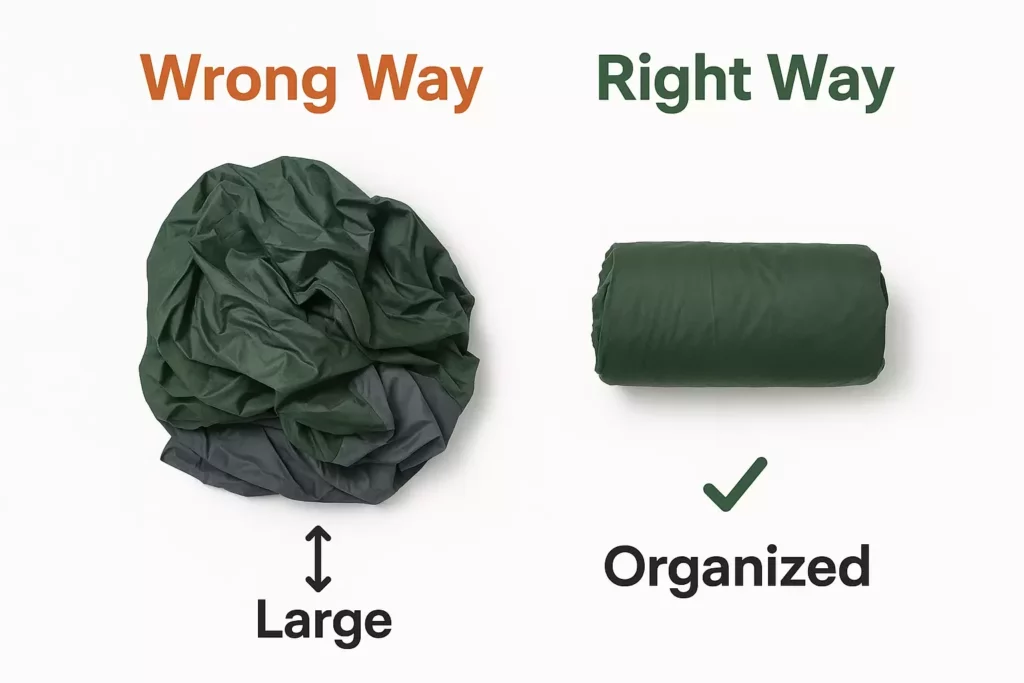
Proper Storage Between Trips
Never store your tent compressed long-term. While compression is necessary for transport, extended compression can damage fabric fibers and reduce waterproofing effectiveness.
Best practices for home storage:
- Store the tent loosely in a large bag or hang it in a closet
- Keep it in a cool, dry location away from direct sunlight
- Periodically inspect for signs of damage or pest intrusion
- Consider storing with moisture-absorbing packets in humid climates
Regular Maintenance Schedule
Implement a simple maintenance routine to extend your tent’s life:
After each trip:
- Clean all components thoroughly
- Inspect for damage and make repairs promptly
- Lubricate zippers with specialized zipper wax
- Check pole connections and shock cord tension
Seasonally:
- Apply waterproofing treatment as needed
- Deep clean with specialized tent cleaners
- Replace worn components before they fail
- Update your camping gear checklist based on performance
When to Seek Professional Help
While most tent folding and maintenance can be handled at home, certain situations warrant professional attention:
Consider professional service for:
- Major fabric repairs or waterproofing restoration
- Pole replacement or shock cord renewal
- Zipper replacement or major zipper repairs
- Warranty claims or manufacturer defects
Many outdoor gear retailers offer tent repair services, and investing in professional maintenance can significantly extend your tent’s lifespan.
Essential Tools and Accessories
Having the right tools makes tent folding significantly easier:
Basic Tool Kit
- Microfiber towels for cleaning and drying
- Zipper lubricant for smooth operation
- Repair tape for emergency fixes
- Stuff sack compression straps for extra compression when needed
Advanced Accessories
- Footprint or tarp to protect tent bottom during folding
- Pole repair sleeves for emergency pole fixes
- Seam sealer for maintaining waterproofing
- Storage bags for organizing hardware and accessories
Consider building a comprehensive camping kit that includes tent maintenance supplies alongside other essential gear.
Interactive Tent Folding Guide
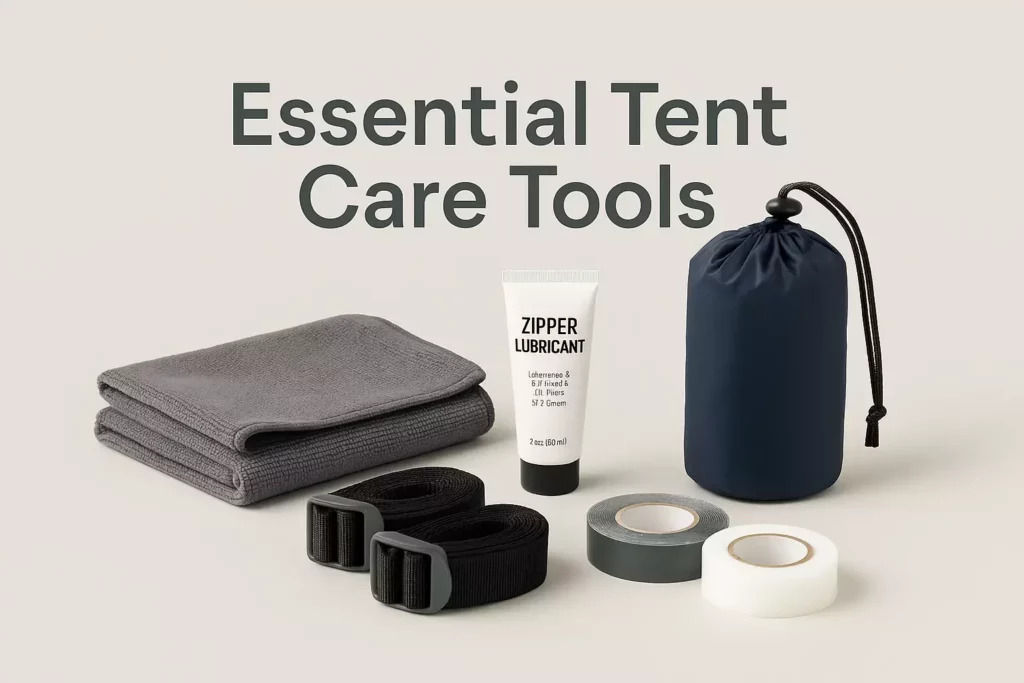
🏕️ Interactive Tent Folding Checklist
Click each step as you complete it to track your progress
Safety Considerations and Best Practices
Weather-Related Precautions
Never attempt to fold a tent in severe weather conditions. High winds can turn tent fabric into a sail, creating dangerous situations and making proper folding impossible.
Safe folding conditions:
- Minimal wind (less than 10 mph)
- Dry conditions when possible
- Adequate lighting for inspection and folding
- Stable, level surface for laying out the tent
Protecting Your Investment
A quality 4-person tent represents a significant investment in your outdoor adventures. Proper folding technique directly correlates with tent longevity and performance.
Financial benefits of proper folding:
- Extended tent lifespan (potentially doubling usable years)
- Reduced need for repairs and replacements
- Maintained warranty coverage
- Better resale value if you upgrade
Consider the cost-per-use calculation: a $300 tent used 20 times per year for 5 years costs just $3 per use. Poor care that cuts the lifespan in half doubles that cost to $6 per use.
Building Your Camping Skills
Mastering tent folding is just one aspect of becoming a proficient camper. Consider developing these complementary skills:
Essential Camping Competencies
Setup and Breakdown Skills:
- Efficient campsite organization
- Proper gear storage and protection
- Leave No Trace principles
Safety and Preparedness:
- Building a comprehensive first aid kit
- Water purification techniques
- Emergency shelter and survival skills
Family Camping Excellence:
- Making camping enjoyable for kids
- Age-appropriate outdoor activities
- Teaching children outdoor responsibility
Gear Management Mastery
Packing and Organization:
- Strategic backpack packing
- Choosing appropriate sleeping systems
- Seasonal gear considerations
Weather Preparedness:
- Selecting proper clothing systems
- Understanding fabric technologies and care
- Outdoor cooking in various conditions
Conclusion
Mastering the art of folding a 4-person tent transforms one of camping’s most frustrating tasks into a quick, efficient process that protects your investment and sets you up for future success. The key lies in systematic preparation, proper technique, and consistent practice.
Remember that every tent is slightly different, and what works perfectly for one model might need adjustment for another. Start by practicing these techniques at home in a controlled environment where you can take your time and experiment with different approaches.
The “burrito roll” method outlined in this guide works for the vast majority of 4-person tents, but don’t be afraid to modify the technique based on your specific tent’s design and your stuff sack’s dimensions. The goal is always the same: create a compact, organized package that protects your tent during transport and storage.
Your Next Steps
- Practice the folding technique with your tent in your backyard or living room
- Create a tent maintenance schedule to keep your gear in optimal condition
- Build a comprehensive camping kit that includes all necessary tools and accessories
- Share these techniques with your camping companions to make group trips more efficient
- Document what works best for your specific tent model and setup
Proper tent care extends far beyond folding – it encompasses cleaning, storage, maintenance, and mindful use. By investing time in learning these skills, you’re not just protecting a piece of equipment; you’re ensuring countless future adventures in the great outdoors.
The satisfaction of smoothly packing up camp while others struggle with their gear is just a bonus. The real reward is the confidence that comes from mastering essential outdoor skills and the knowledge that your equipment will be ready when adventure calls.


